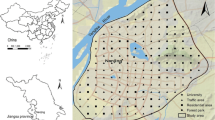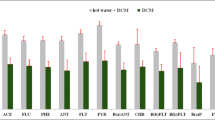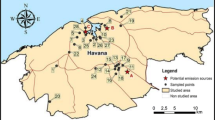Abstract
This study investigates the levels, sources, spatial distribution, and toxicity of polycyclic aromatic hydrocarbons (PAHs) in urban soils of Tyumen, Russia. Observations of PAHs in cities of Western Siberia accomplished by a representative set of samples are very rare, even though it is one of the most urbanized parts of Russia. Therefore, it is important to estimate the status of PAHs in soils of urban environments representing vast Siberian regions. Tyumen, as one of the most intensively developing cities of Western Siberia, is a good object for such studies. Topsoil samples (0–10 cm) were collected from 241 sampling sites on a regular grid within Tyumen city limits. It was found that total concentration of 12 priority PAHs ranged from 33.4 to 2147.9 μg kg−1, with a median value of 280.3 μg kg−1. High-molecular-weight (HMW) PAHs were dominant, accounting for the majority (62%) of the total PAHs. Among the PAHs in soils, 4-ring compounds were predominant in all studied samples, followed by 5- and 6-ring PAHs. Phenanthrene, pyrene, fluoranthene, and benzo(ghi)perylene had values of 28%, 19%, 15%, and 10% of total PAHs, respectively. Results showed that large high-contrast anomalies of HMW PAHs were related to low-residential and transport areas. The diagnostic ratios, as well as hierarchical cluster analysis (HCA) and principal component analysis (PCA), confirmed that sources associated with the transport were the most significant, while biomass combustion played an important role as a source of PAHs in agricultural, low-residential, and recreational areas. Levels of individual PAHs, as well as total PAHs in urban soils of Tyumen, were comparable with those in non-industrial cities with similar populations but were significantly lower than those in large industrial centers. Assessment of soil toxicity using toxic equivalent quantity (TEQBaP) showed that the TEQBaP values varied from 2.0 to 388.2 μg kg−1, with a mean value of 34.9 μg kg−1 and median of 19.8 μg kg−1, and were lower than those in heavy industrialized cities, but higher than those in soils of cities specializing in consumer and service industries.








Similar content being viewed by others
References
Abakumov, E. V., Lodygin, E. D., Gabov, D. A., & Krylenkov, V. A. (2014). Polycyclic aromatic hydrocarbons content in Antarctica soils as exemplified by the Russian polar stations. Gigiena i sanitaria,1, 30–34. (in Rus).
Abakumov, E. V., Tomashunas, V. M., Lodygin, E. D., Gabov, D. N., Sokolov, V. T., Krylenkov, V. A., et al. (2015). Polycyclic aromatic hydrocarbons in insular and coastal soils of the Russian Arctic. Eurasian Soil Science,48(12), 1300–1305. https://doi.org/10.1134/S1064229315120029.
Abdel-Shafy, H. I., & Mansour, M. S. M. (2016). A review on polycyclic aromatic hydrocarbons: Source, environmental impact, effect on human health and remediation. Egyptian Journal of Petroleum,25(1), 107–123. https://doi.org/10.1016/j.ejpe.2015.03.011.
Angelone, M., & Udovic, M. (2014). Potentially harmful elements in urban soils. In C. Bini & J. Bech (Eds.), PHEs, Environment and Human Health (pp. 221–251). Dordrecht: Springer. https://doi.org/10.1007/978-94-017-8965-3_6.
Bao, H., Hou, S., Niu, H., Tian, K., Liu, X., & Wu, F. (2018). Status, sources, and risk assessment of polycyclic aromatic hydrocarbons in urban soils of Xi’an, China. Environmental Science and Pollution Research,25(19), 18947–18959. https://doi.org/10.1007/s11356-018-1928-z.
BBodSchV. (1999). Bundes-Bodenschutz- und Altlastenverordnung (BBodSchV) vom 12. Juli 1999 (BGBl. I S. 1554), die zuletzt durch Artikel 3 Absatz 4 der Verordnung vom 27. September 2017 (BGBl. I S. 3465) geändert worden ist. http://www.gesetze-im-internet.de/bbodschv/BBodSchV.pdf. Accessed 09 November 2018.
Bojakowska, I., Tomassi-Morawiec, H., & Markowski, W. (2018). PAHs and DDTs in soil and sediment of inland water bodies of Warsaw city and its surroundings. Journal of Geochemical Exploration,187, 57–71. https://doi.org/10.1016/j.gexplo.2017.07.013.
Bull, K. (2003). Protocol to the 1979 convention on long-range transboundary air pollution on persistent organic pollutants: the 1998 agreement for the UNECE region. In H. Fielder (Ed.), Persistent organic pollutants (pp. 1–11). Berlin, Heidelber: Springer.
Cao, H., Chao, S., Qiao, L., Jiang, Y., Zeng, X., & Fan, X. (2017). Urbanization-related changes in soil PAHs and potential health risks of emission sources in a township in Southern Jiangsu, China. Science of the Total Environment,575, 692–700. https://doi.org/10.1016/j.scitotenv.2016.09.106.
CCME (Canadian Council of Ministers of the Environment). (2010). Canadian soil quality guidelines for the protection of environmental and human health: Carcinogenic and Other PAHs. In: Canadian environmental quality guidelines, 1999. Winnipeg: Canadian Council of Ministers of the Environment.
Cetin, B. (2016). Investigation of PAHs, PCBs and PCNs in soils around a Heavily Industrialized Area in Kocaeli, Turkey: Concentrations, distributions, sources and toxicological effects. Science of the Total Environment,560–561, 160–169. https://doi.org/10.1016/j.scitotenv.2016.04.037.
Chen, M., Huang, P., & Chen, L. (2013). Polycyclic aromatic hydrocarbons in soils from Urumqi, China: distribution, source contributions, and potential health risks. Environmental Monitoring and Assessment, 185, 5639–5651. https://doi.org/10.1007/s10661-012-2973-6.
Edwards, N. T. (1983). Polycyclic aromatic hydrocarbons (PAH’s) in the terrestrial environment—a review. Journal of Environmental Quality,12(4), 427–441.
Federal State Statistics Service. (2016). Regiony Rossii. Osnovnye sotsial’no-ekonomicheskie pokazateli gorodov - 2016 g. [Regions of Russia. Main socio-economic indicators of cities - 2016]. http://www.gks.ru/bgd/regl/b16_14t/Main.htm. Accessed 15 November 2018.
Federal State Statistics Service. (2018). Database of indicators of municipalities. Tyumen Region. http://www.gks.ru/dbscripts/munst/munst71/DBInet.cgi#1. Accessed 26 December 2018.
Glennon, M., Scanlon, R. P., O’Connor, P. J., Finne, T. E., Andersson, M., Eggen, O., Jensen, H. K. B., & Ottesen, R. T. (2012). Dublin SURGE Project. Geochemical baseline for heavy metals and organic pollutants in topsoils in the greater Dublin area. Technical report. Dublin: Geological Survey of Ireland.
GN 2.1.7.2041-06. (2006). Predelno dopustimye kontsentratsii (PDK) khimicheskikh veshchestv v pochve [Hygienic standards 2.1.7.2041-06. Maximum permissible concentration (MPC) of chemical substances in the soil]. Byulleten normativnykh aktov federalnykh organov ispolnitelnoi vlasti, 10.
Government of the Tyumen region. (2018). Doklad ob ekologicheskoy situatsii v Tyumenskoy oblasti v 2017 godu [Report on the environmental situation in the Tyumen region in 2017]. https://admtyumen.ru/files/upload/OIV/D_nedro/Дoкyмeнты/Дoклaд%20oб%20экoлoгичecкoй%20cитyaции%20в%20Tюмeнcкoй%20oблacти%20в%202017%20гoдy(1).pdf. Accessed 05 December 2018.
Grimmer, G. (1983). Occurrence of PAH. In G. Grimmer (Ed.), Environmental carcinogens: polycyclic aromatic hydrocarbons. Chemistry, occurrence, biochemistry, carcinogenicity (pp. 61–128). Boca Raton: CRC Press.
Hayakawa, K. (2018). Chemistry of polycyclic aromatic hydrocarbons (PAHs), Nitropolycyclic aromatic hydrocarbons (NPAHs) and other oxidative derivatives of PAHs. In K. Hayakawa (Ed.), Polycyclic aromatic hydrocarbons: Environmental behavior and toxicity in East Asia (pp. 3–10). Singapore: Springer. https://doi.org/10.1007/978-981-10-6775-4_1.
Hiller, E., Lachká, L., Jurkovič, L., & Vozár, J. (2015). Polycyclic aromatic hydrocarbons in urban soils from kindergartens and playgrounds in Bratislava, the capital city of Slovakia. Environmental Earth Sciences,73(11), 7147–7156. https://doi.org/10.1007/s12665-014-3894-1.
IARC. (2018). List of classifications, volumes 1–123. https://monographs.iarc.fr/list-of-classifications-volumes/. Accessed 05 November 2018.
Islam, M. N., Park, M., Jo, Y.-T., Nguyen, X. P., Park, S.-S., Chung, S.-Y., et al. (2017). Distribution, sources, and toxicity assessment of polycyclic aromatic hydrocarbons in surface soils of the Gwangju City, Korea. Journal of Geochemical Exploration,180, 52–60. https://doi.org/10.1016/j.gexplo.2017.06.009.
ISO 13859:2014. Soil quality - Determination of polycyclic aromatic hydrocarbons (PAH) by gas chromatography (GC) and high performance liquid chromatography (HPLC).
Jiang, Y., Yves, U. J., Sun, H., Hu, X., Zhan, H., & Wu, Y. (2016). Distribution, compositional pattern and sources of polycyclic aromatic hydrocarbons in urban soils of an industrial city, Lanzhou, China. Ecotoxicology and Environmental Safety,126, 154–162. https://doi.org/10.1016/j.ecoenv.2015.12.037.
Kay, R. T., Arnold, T. L., Cannon, W. F., & Graham, D. (2008). Concentrations of polycyclic aromatic hydrocarbons and inorganic constituents in ambient surface soils, Chicago, Illinois: 2001–2002. Soil and Sediment Contamination: An International Journal,17(3), 221–236. https://doi.org/10.1080/15320380802006939.
Kazakov, K. (2019). Pogoda I Klimat [Weather and Climate]. http://www.pogodaiklimat.ru/climate/28367.htm. Accessed 12 January 2019.
Konstantinova, E Yu., Sushkova, S. N., Minkina, T. M., Antonenko, E. M., Konstantinov, A. O., & Khoroshavin, V Yu. (2018). Polycyclic aromatic hydrocarbons in soils of industrial and residential areas of Tyumen. Bulletin of the Tomsk Polytechnic University-Geo Assets Engineering,329(8), 66–79. (in Rus).
Kotelnikova, I. M., Sergeev, A. G., & Kuimova, N. G. (2013). Polycyclic aromatic hydrocarbons in snow cover and soils of Blagoveshchenskcity. Ecology and Industry of Russia,4, 44–50. https://doi.org/10.18412/1816-0395-2013-4-44-50. (in Rus).
Kwon, H.-O., & Choi, S.-D. (2014). Polycyclic aromatic hydrocarbons (PAHs) in soils from a multi-industrial city, South Korea. Science of the Total Environment,470–471, 1494–1501. https://doi.org/10.1016/j.scitotenv.2013.08.031.
Maliszewska-Kordybach, B. (1996). Polycyclic aromatic hydrocarbons in agricultural soils in Poland: preliminary proposals for criteria to evaluate the level of soil contamination. Applied Geochemistry,11(1), 121–127. https://doi.org/10.1016/0883-2927(95)00076-3.
Minkina, T., Sushkova, S., Konstantinova, E., Kumar Yadav, B., Mandzhieva, S., Konstantinov, A., et al. (2019). Polycyclic aromatic hydrocarbons in Urban Soils within the different land use: a case study of Tyumen, Russia. Polycyclic Aromatic Compounds. https://doi.org/10.1080/10406638.2018.1540997.
Mohit, A., Keshavarzi, B., & Moore, F. (2018). Polycyclic aromatic hydrocarbons (PAHs) in urban soils of Ahvaz metropolis; contamination, composition, distribution, potential sources, and cancer risk. Human and Ecological Risk Assessment: An International Journal. https://doi.org/10.1080/10807039.2018.1456900.
Morillo, E., Romero, A. S., Madrid, L., Villaverde, J., & Maqueda, C. (2008). Characterization and sources of PAHs and potentially toxic metals in urban environments of Sevilla (Southern Spain). Water, Air, and Soil Pollution,187(1–4), 41–51. https://doi.org/10.1007/s11270-007-9495-9.
Morillo, E., Romero, A. S., Maqueda, C., Madrid, L., Ajmone-Marsan, F., Grcman, H., et al. (2007). Soil pollution by PAHs in urban soils: A comparison of three European cities. Journal of Environmental Monitoring,9(9), 1001–1008. https://doi.org/10.1039/B705955H.
MU 2.1.7.730-99. (1999). Gigienicheskaya otsenka kachestva pochvy naselennykh mest. Metodicheskie ukazaniya [Hygienic assessment of soil quality in populated areas. Methodical instructions] (approved by the Ministry of Health of the Russian Federation on 07 February 1999).
Nikiforova, E. M., & Kosheleva, N. E. (2011). Polycyclic aromatic hydrocarbons in urban soils (Moscow, Eastern District). Eurasian Soil Science,44(9), 1018–1030. https://doi.org/10.1134/S1064229311090092.
Nisbet, I. C. T., & LaGoy, P. K. (1992). Toxic equivalency factors (TEFs) for polycyclic aromatic hydrocarbons (PAHs). Regulatory Toxicology and Pharmacology,16(3), 290–300. https://doi.org/10.1016/0273-2300(92)90009-X.
Perelman, A. I., & Kasimov, N. S. (1999). Geokhimiya landshafta [Landscape geochemistry]. Moscow: Astreya-2000. (in Rus).
RD 52.10.556-95. 2002. Rukovodyashchii dokument. Metodicheskie ukazaniya. Opredelenie zagryaznyayushchikh veshchestv v probakh morskikh donnykh otlozhenii i vzvesi [Guidance document. Methodical instructions. Determination of pollutants in samples of marine sediments and suspended matter] (approved by Rosgidromet on 04 August 1995) (revised as 03 April 2014). SPS Consultant Plus.
Saltiene, Z., Brukstiene, D., & Ruzgyte, A. (2002). Contamination of soil by polycyclic aromatic hydrocarbons in some urban areas. Polycyclic Aromatic Compounds,22, 23–35. https://doi.org/10.1080/10406630210371.
Schwarzbauer, J., & Jovančićević, B. (2018). Organic pollutants in the geosphere. Fundamentals in organic geochemistry. Cham: Springer.
Shamilishvily, G., Abakumov, E., & Gabov, D. (2018). Polycyclic aromatic hydrocarbon in urban soils of an Eastern European megalopolis: distribution, source identification and cancer risk evaluation. Solid Earth,9, 669–682. https://doi.org/10.5194/se-9-669-2018.
Singh, D. P., Gadi, Ranu, & Mandal, T. K. (2012). Levels, sources, and toxic potential of polycyclic aromatic hydrocarbons in urban soil of Delhi, India. Human and Ecological Risk Assessment: An International Journal,18(2), 393–411. https://doi.org/10.1080/10807039.2012.652461.
Sushkova, S. N., Minkina, T., Deryabkina, I., Mandzhieva, S., Zamulina, I., Bauer, T., et al. (2018). Influence of PAH contamination on soil ecological status. Journal of Soils and Sediments,18(6), 2368–2378. https://doi.org/10.1007/s11368-017-1755-8.
Sushkova, S., Minkina, T., Deryabkina, I., Rajput, V., Antonenko, E., Nazarenko, O., et al. (2019). Environmental pollution of soil with PAHs in energy producing plants zone. Science of the Total Environment,655, 232–241. https://doi.org/10.1016/j.scitotenv.2018.11.080.
Sushkova, S. N., Minkina, T. M., Mandzhieva, S. S., Deryabkina, I. G., Vasil’eva, G. K., & Kızılkaya, R. (2017). Dynamics of benzo[α]pyrene accumulation in soils under the influence of aerotechnogenic emissions. Eurasian Soil Science,50(1), 95–105. https://doi.org/10.1134/S1064229317010148.
Tobiszewski, M., & Namieśnik, J. (2012). PAH diagnostic ratios for the identification of pollution emission sources. Environmental Pollution,162, 110–119. https://doi.org/10.1016/j.envpol.2011.10.025.
Tsibart, A. S., & Gennadiev, A. N. (2013). Polycyclic aromatic hydrocarbons in soils: Sources, behavior, and indication significance (a review). Eurasian Soil Science,46(7), 728–741. https://doi.org/10.1134/S1064229313070090.
U.S. EPA. (2015). Appendix A to 40 CFR, Part 423–126 Priority Pollutants. https://www.gpo.gov/fdsys/pkg/CFR-2018-title40-vol31/pdf/CFR-2018-title40-vol31-part423-appA.pdf. Accessed 09 November 2018.
Vane, C. H., Kim, A. W., Beriro, D. J., Cave, M. R., Knights, K., Moss-Hayes, V., et al. (2014). Polycyclic aromatic hydrocarbons (PAH) and polychlorinated biphenyls (PCB) in urban soils of Greater London, UK. Applied Geochemistry,51, 303–314. https://doi.org/10.1016/j.apgeochem.2014.09.013.
Verbruggen, E. M. J. (2012). Environmental risk limits for polycyclic aromatic hydrocarbons (PAHs). For direct aquatic, benthic, and terrestrial toxicity. RIVM report 607711007/2012. Bilthoven: National Institute for Public Health and the Environment.
Volk, S., & Gratzfeld-Huesgen, A. (2011). Agilent application solution: Analysis of PAHs in soil according to EPA 8310 method with UV and fluorescence detection. Santa Clara: Agilent Technologies Inc.
Vorobyova, L. A. (2006). Theory and practice of chemical analysis of soils. Moscow: GEOS. (in Rus).
Wang, L., Xu, X., & Lu, X. (2016). Composition, source and potential risk of polycyclic aromatic hydrocarbons (PAHs) in vegetable soil from the suburbs of Xianyang City, Northwest China: A case study. Environmental Earth Sciences,75, 56. https://doi.org/10.1007/s12665-015-4853-1.
Wang, L., Zhang, S., Wang, L., Zhang, W., Shi, X., Lu, X., et al. (2018). Concentration and risk evaluation of polycyclic aromatic hydrocarbons in urban soil in the typical semi-arid city of Xi’an in Northwest China. International Journal of Environmental Research and Public Health,15, 607. https://doi.org/10.3390/ijerph15040607.
Yang, J., Yu, F., Yu, Y., Zhang, J., Wang, R., Srinivasulu, M., et al. (2017). Characterization, source apportionment, and risk assessment of polycyclic aromatic hydrocarbons in urban soil of Nanjing, China. Journal of Soils and Sediments,17(4), 1116–1125. https://doi.org/10.1007/s11368-016-1585-0.
Yaroshchuk, A. V., Maksimenko, E. V., & Borisenko, N. I. (2003). Razrabotka metodiki izvlecheniya benz(a)pirena iz pochv [Development of a technique for extracting benzo[a]pyrene from soils]. Izvestiya vuzov. Severo - Kavkazskii region. Natural Sciences. Prilozhenie, 2003, 9, 44–46.
Yunker, M. B., Perreault, A., & Lowe, C. J. (2012). Source apportionment of elevated PAH concentrations in sediments near deep marine outfalls in Esquimalt and Victoria, BC, Canada: Is coal from an 1891 shipwreck the source? Organic Geochemistry,46, 12–37. https://doi.org/10.1016/j.orggeochem.2012.01.006.
Acknowledgements
This project was funded by the Russian Foundation for Basic Research within the scientific project No 17-35-50055 mol_nr.
Author information
Authors and Affiliations
Corresponding author
Additional information
Publisher's Note
Springer Nature remains neutral with regard to jurisdictional claims in published maps and institutional affiliations.
Rights and permissions
About this article
Cite this article
Konstantinova, E., Minkina, T., Sushkova, S. et al. Levels, sources, and toxicity assessment of polycyclic aromatic hydrocarbons in urban topsoils of an intensively developing Western Siberian city. Environ Geochem Health 42, 325–341 (2020). https://doi.org/10.1007/s10653-019-00357-9
Received:
Accepted:
Published:
Issue Date:
DOI: https://doi.org/10.1007/s10653-019-00357-9




